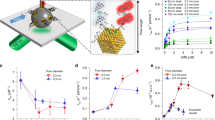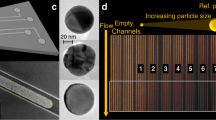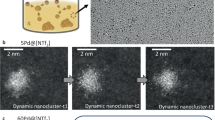Abstract
Understanding the fundamental catalytic principles when the catalytic centre is confined in nanoscale space that is dimensionally comparable to the reactant molecule is crucial for designing high-performance catalysts. Theoretical studies with simplified model systems and ensemble experimental measurements have shown that chemical reactions in nanoconfined environments are largely different from those in bulk solution. Here, we design a well-defined platform with catalytic centres confined in the end of nanopores with controlled lengths to study the in situ dynamic behaviour of catalytic processes under nanoconfinement at the single-molecule and single-particle level. Variable single molecular mass transport behaviour reveals the heterogeneity of the confined environment in the nanopores. With the capability of decoupling mass transport factors from reaction kinetics in the well-defined platform, we quantitatively uncovered a confinement-induced enhancement in the activity of platinum nanoparticles inside the nanopores. The combination of the unique model catalyst and the single-molecule super-localization imaging technique paves the way to understanding nanoconfinement effects in catalysis.
This is a preview of subscription content, access via your institution
Access options
Access Nature and 54 other Nature Portfolio journals
Get Nature+, our best-value online-access subscription
$29.99 / 30 days
cancel any time
Subscribe to this journal
Receive 12 digital issues and online access to articles
$119.00 per year
only $9.92 per issue
Buy this article
- Purchase on Springer Link
- Instant access to full article PDF
Prices may be subject to local taxes which are calculated during checkout




Similar content being viewed by others
References
Petrosko, S. H., Johnson, R., White, H. & Mirkin, C. A. Nanoreactors: small spaces, big implications in chemistry. J. Am. Chem. Soc. 138, 7443–7445 (2016).
Yang, F., Deng, D., Pan, X., Fu, Q. & Bao, X. Understanding nano effects in catalysis. Natl Sci. Rev. 2, 183–201 (2015).
Lísal, M., Brennan, J. K. & Smith, W. R. Chemical reaction equilibrium in nanoporous materials: NO dimerization reaction in carbon slit nanopores. J. Chem. Phys. 124, 64712 (2006).
Jakobtorweihen, S., Hansen, N. & Keil, F. J. Combining reactive and configurational-bias Monte Carlo: confinement influence on the propene metathesis reaction system in various zeolites. J. Chem. Phys. 125, 224709 (2006).
Santiso, E. E., Kostov, M. K., George, A. M., Nardelli, M. B. & Gubbins, K. E. Confinement effects on chemical reactions—toward an integrated rational catalyst design. Appl. Surf. Sci. 253, 5570–5579 (2007).
Malijevský, A. & Lísal, M. Density functional study of chemical reaction equilibrium for dimerization reactions in slit and cylindrical nanopores. J. Chem. Phys. 130, 164713 (2009).
Santiso, E. E., George, A. M., Gubbins, K. E. & Nardelli, M. B. Effect of confinement by porous carbons on the unimolecular decomposition of formaldehyde. J. Chem. Phys. 125, 084711 (2006).
Hansen, N., Jakobtorweihen, S. & Keil, F. J. Reactive Monte Carlo and grand-canonical Monte Carlo simulations of the propene metathesis reaction system. J. Chem. Phys. 122, 164705 (2005).
Santiso, E. E., Nardelli, M. B. & Gubbins, K. E. A remarkable shape-catalytic effect of confinement on the rotational isomerization of small hydrocarbons. J. Chem. Phys. 128, 034704 (2008).
Xiao, J., Pan, X., Guo, S., Ren, P. & Bao, X. Toward fundamentals of confined catalysis in carbon nanotubes. J. Am. Chem. Soc. 137, 477–482 (2015).
Bae, J. H., Han, J.-H., Han, D. & Chung, T. D. Effects of adsorption and confinement on nanoporous electrochemistry. Farad. Discuss. 164, 361–376 (2013).
Bi, H., Qiao, L., Busnel, J.-M., Liu, B. & Girault, H. H. Kinetics of proteolytic reactions in nanoporous materials. J. Proteome Res. 8, 4685–4692 (2009).
Chen, P.-C. et al. Tip-directed synthesis of multimetallic nanoparticles. J. Am. Chem. Soc. 137, 9167–9173 (2015).
Deraedt, C. & Astruc, D. Supramolecular nanoreactors for catalysis. Coord. Chem. Rev. 324, 106–122 (2016).
Deraedt, C., Pinaud, N. & Astruc, D. Recyclable catalytic dendrimer nanoreactor for part-per-million cuI catalysis of “click” chemistry in water. J. Am. Chem. Soc. 136, 12092–12098 (2014).
Grochmal, A., Prout, L., Makin-Taylor, R., Prohens, R. & Tomas, S. Modulation of reactivity in the cavity of liposomes promotes the formation of peptide bonds. J. Am. Chem. Soc. 137, 12269–12275 (2015).
Li, G. et al. Giant Raman response to the encapsulation of sulfur in narrow diameter single-walled carbon nanotubes. J. Am. Chem. Soc. 138, 40–43 (2016).
Liu, H., Yu, H., Xiong, C. & Zhou, S. Architecture controlled PtNi@mSiO2 and Pt–NiO@mSiO2 mesoporous core–shell nanocatalysts for enhanced p-chloronitrobenzene hydrogenation selectivity. RSC Adv. 5, 20238–20247 (2015).
Tagliazucchi, M. & Szleifer, I. How does confinement change ligand–receptor binding equilibrium? Protein binding in nanopores and nanochannels. J. Am. Chem. Soc. 137, 12539–12551 (2015).
Zhai, B. et al. Enhanced hydrogen desorption properties of LiBH4–Ca(BH4)2 by a synergetic effect of nanoconfinement and catalysis. Int. J. Hydrog. Energy 41, 17462–17470 (2016).
Zhao, H. et al. Reversible trapping and reaction acceleration within dynamically self-assembling nanoflasks. Nat. Nanotech. 11, 82–88 (2016).
Zurner, A., Kirstein, J., Doblinger, M., Bräuchle, C. & Bein, T. Visualizing single-molecule diffusion in mesoporous materials. Nature 450, 705–708 (2007).
Tran-Ba, K.-H., Finley, J. J., Higgins, D. A. & Ito, T. Single-molecule tracking studies of millimeter-scale cylindrical domain alignment in polystyrene–poly(ethylene oxide) diblock copolymer films induced by solvent vapor penetration. J. Phys. Chem. Lett. 3, 1968–1973 (2012).
Jung, C. et al. Diffusion of oriented single molecules with switchable mobility in networks of long unidimensional nanochannels. J. Am. Chem. Soc. 130, 1638–1648 (2008).
Feil, F., Cauda, V., Bein, T. & Bräuchle, C. Direct visualization of dye and oligonucleotide diffusion in silica filaments with collinear mesopores. Nano Lett. 12, 1354–1361 (2012).
Rühle, B., Davies, M., Lebold, T., Bräuchle, C. & Bein, T. Highly oriented mesoporous silica channels synthesized in microgrooves and visualized with single-molecule diffusion. ACS Nano 6, 1948–1960 (2012).
Lebold, T., Michaelis, J. & Brauchle, C. The complexity of mesoporous silica nanomaterials unravelled by single molecule microscopy. Phys. Chem. Chem. Phys. 13, 5017–5033 (2011).
Roeffaers, M. B. J. et al. Spatially resolved observation of crystal-face-dependent catalysis by single turnover counting. Nature 439, 572–575 (2006).
Ristanović, Z. et al. Quantitative 3D fluorescence imaging of single catalytic turnovers reveals spatiotemporal gradients in reactivity of zeolite H-ZSM-5 crystals upon steaming. J. Am. Chem. Soc. 137, 6559–6568 (2015).
Ristanović, Z., Kubarev, A. V., Hofkens, J., Roeffaers, M. B. J. & Weckhuysen, B. M. Single molecule nanospectroscopy visualizes proton-transfer processes within a zeolite crystal. J. Am. Chem. Soc. 138, 13586–13596 (2016).
Roeffaers, M. B. J. et al. Super-resolution reactivity mapping of nanostructured catalyst particles. Angew. Chem. Int. Ed. 121, 9449–9453 (2009).
Ristanović, Z. et al. High-resolution single-molecule fluorescence imaging of zeolite aggregates within real-life fluid catalytic cracking particles. Angew. Chem. Int. Ed. 54, 1836–1840 (2015).
Hendriks, F. C. et al. Single-molecule fluorescence microscopy reveals local diffusion coefficients in the pore network of an individual catalyst particle. J. Am. Chem. Soc. 139, 13632–13635 (2017).
Zhou, X. et al. Quantitative super-resolution imaging uncovers reactivity patterns on single nanocatalysts. Nat. Nanotech. 7, 237–241 (2012).
Han, K. S., Liu, G., Zhou, X., Medina, R. E. & Chen, P. How does a single Pt nanocatalyst behave in two different reactions? A single-molecule study. Nano Lett. 12, 1253–1259 (2012).
Andoy, N. M. et al. Single-molecule catalysis mapping quantifies site-specific activity and uncovers radial activity gradient on single 2D nanocrystals. J. Am. Chem. Soc. 135, 1845–1852 (2013).
Xu, W., Kong, J. S., Yeh, Y.-T. E. & Chen, P. Single-molecule nanocatalysis reveals heterogeneous reaction pathways and catalytic dynamics. Nat. Mater. 7, 992–996 (2008).
Ha, J. W. et al. Super-resolution mapping of photogenerated electron and hole separation in single metal–semiconductor nanocatalysts. J. Am. Chem. Soc. 136, 1398–1408 (2014).
Tachikawa, T., Yamashita, S. & Majima, T. Evidence for crystal-face-dependent TiO2 photocatalysis from single-molecule imaging and kinetic analysis. J. Am. Chem. Soc. 133, 7197–7204 (2011).
Sambur, J. B. et al. Sub-particle reaction and photocurrent mapping to optimize catalyst-modified photoanodes. Nature 530, 77–80 (2016).
Sambur, J. B. & Chen, P. Distinguishing direct and indirect photoelectrocatalytic oxidation mechanisms using quantitative single-molecule reaction imaging and photocurrent measurements. J. Phys. Chem. C 120, 20668–20676 (2016).
De Cremer, G. et al. High-resolution single-turnover mapping reveals intraparticle diffusion limitation in Ti–MCM-41-catalyzed epoxidation. Angew. Chem. Int. Ed. 122, 920–923 (2010).
Kubarev, A. V., Janssen, K. P. F. & Roeffaers, M. B. J. Noninvasive nanoscopy uncovers the impact of the hierarchical porous structure on the catalytic activity of single dealuminated mordenite crystals. ChemCatChem 7, 3646–3650 (2015).
Joo, S. H. et al. Thermally stable Pt/mesoporous silica core–shell nanocatalysts for high-temperature reactions. Nat. Mater. 8, 126–131 (2009).
Schilling, E. A., Kamholz, A. E. & Yager, P. Cell lysis and protein extraction in a microfluidic device with detection by a fluorogenic enzyme assay. Anal. Chem. 74, 1798–1804 (2002).
Li, L., Kazoe, Y., Mawatari, K., Sugii, Y. & Kitamori, T. Viscosity and wetting property of water confined in extended nanospace simultaneously measured from highly-pressurized meniscus motion. J. Phys. Chem. Lett. 3, 2447–2452 (2012).
Acknowledgements
This work was supported by the National Science Foundation (CHE-1609225/1607305).
Author information
Authors and Affiliations
Contributions
B.D., Y.P., W.H. and N.F. conceived the idea, designed the experiments and wrote the manuscript. B.D., F.Z., K.C. and N.F. performed the imaging experiments. Y.P., T.W.G., Z.Q., C.X. and W.H. performed the synthesis and characterization of the nanocatalysts.
Corresponding authors
Ethics declarations
Competing interests
The authors declare no competing financial interests.
Additional information
Publisher’s note: Springer Nature remains neutral with regard to jurisdictional claims in published maps and institutional affiliations.
Supplementary information
Supplementary Information
Supplementary Methods; Supplementary Tables 1– 2; Supplementary Figures 1–24; Supplementary Notes; Supplementary References
Rights and permissions
About this article
Cite this article
Dong, B., Pei, Y., Zhao, F. et al. In situ quantitative single-molecule study of dynamic catalytic processes in nanoconfinement. Nat Catal 1, 135–140 (2018). https://doi.org/10.1038/s41929-017-0021-1
Received:
Accepted:
Published:
Issue Date:
DOI: https://doi.org/10.1038/s41929-017-0021-1
This article is cited by
-
The role of halogens in Au–S bond cleavage for energy-differentiated catalysis at the single-bond limit
Nature Communications (2023)
-
Dynamic imaging of interfacial electrochemistry on single Ag nanowires by azimuth-modulated plasmonic scattering interferometry
Nature Communications (2023)
-
Exceptional catalytic activity of oxygen evolution reaction via two-dimensional graphene multilayer confined metal-organic frameworks
Nature Communications (2022)
-
Classification-based motion analysis of single-molecule trajectories using DiffusionLab
Scientific Reports (2022)
-
Recent progress in single-molecule fluorescence technology in nanocatalysis
Nano Research (2022)



